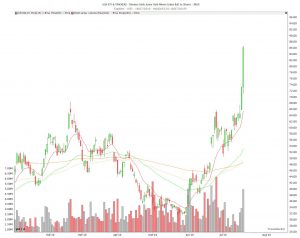Reverse Stock Splits: The Pros & Cons
Reverse stock split is the term which is used in the context of corporate restructuring, it refers to that procedure through which a company or ETF distributor reduces the number of shares which are available in the market.
The effect of reverse stock split is that it increases the share price of the stock of the company or ETF. However reverse splits reduce a company’s outstanding shares (in my case exchanging 5 shares to get one). It’s the opposite of a regular, or forward, stock split in which a company increases its shares. But just like a forward stock split, a reverse split doesn’t add—or reduce—a company’s market cap or value.
For example, a company with five million outstanding shares trading at $1/share has a market cap of $5 million. If it decides to affect a 1-2 reverse stock split, that reduces the number of shares to 2.5 million. Its market cap remains the same—$5 million—so with 2.5 million shares outstanding, the share price is now $2 ($5 million divided by 2.5 million shares). Nothing changed except a reduction in the number of outstanding shares, which doubled the stock price.
Given below are the advantages and disadvantages of reverse stock split
Advantages of reverse stock split
- Due to reverse stock split the shares of company in the market are reduced which in turn makes it harder for any trader to short sell the stock because short selling is done for those stock which are very liquid as it is easy to borrow such stocks and traders have confidence that in case of stock price rise they can square off the position due to good liquidity, however when stock is illiquid they will think 10 times before shorting the stock and hence in a way reverse stock split reduces speculation in the stock price and only serious investors buy or sell the share.
- A reverse stock split is usually done by companies whose stock price has fallen too low for companies comfort so a stock which before reverse stock split was 1 dollar and if company do reverse stock split in the ratio of 1 is to 5 then after the process is complete than everything remaining constant the new share price would be 5 dollar.
- Reverse stock split is helpful when company wants to reduce its shareholder base because a large scattered base of shareholders may lead to delay in decision making as for any scheme to start it needs shareholders approval as they are entitled to vote and a large scattered base will result in divided opinion and hence the delay.

Disadvantages of reverse stock split
- The biggest disadvantage of reverse stock split is that it reduces the liquidity of shares in the market and since illiquid shares are not traded that much it may not lead to proper price discovery of the stock price.
- Small shareholders are left with even less shares and sometimes they receive cash because their shares are insufficient when it comes to reverse stock split and hence it leads to accumulation of stock by big players and small shareholders stands to lose.
- Reverse stock is taken negatively by the markets because it may be a sign that company is doing this for increasing the share price and therefore it may lead lower valuation of the company after reverse stock split.
ETF impacted by Reverse Split
If you follow this blog, you know that I have been following Gold and Gold miners ETF. I have been writing puts on the Direxion Daily Junior Gold Miners Index Bull 3X Shares ETF.
In my kids portfolio I got 400 shares and in my own portfolio 300 shares of JNUG. The price was hoovering around 10$. Take a look at the chart now.

In May Direxion announced it will execute a reverse split of the issued and outstanding shares of the Direxion Daily Mid Cap Bear 3X Shares, Direxion Daily Small Cap Bear 3X Shares, Direxion Daily Financial Bear 3X Shares, Direxion Daily S&P Oil & Gas Exp. & Prod.Bear 3X Shares, Direxion Daily Natural Gas Related Bull 3X Shares, Direxion Daily Junior Gold Miners Index Bull 3X Shares, Direxion Daily Daily MSCI Real Estate Bear 3X Shares and the Direxion Daily Semiconductor Bear 3X Shares (each a “Fund” and collectively the “Funds”).
After the close of the markets on June 27, 2019, the Funds were affect reverse splits of their issued and outstanding shares as follows:
|
Fund Name |
Reverse |
Approximate decrease in |
|
Direxion Daily Mid Cap Bear 3X Shares |
1 for 5 |
80% |
|
Direxion Daily Small Cap Bear 3X Shares |
1 for 5 |
80% |
|
Direxion Daily Financial Bear 3X Shares |
1 for 5 |
80% |
|
Direxion Daily S&P Oil & Gas Exp. & Prod.Bear 3X |
1 for 5 |
80% |
|
Direxion Daily Natural Gas Related Bull 3X Shares |
1 for 5 |
80% |
|
Direxion Daily Junior Gold Miners Index Bull 3X Shares JNUG |
1 for 5 |
80% |
|
Direxion Daily Daily MSCI Real Estate Bear 3X Shares |
1 for 5 |
80% |
|
Direxion Daily Semiconductor Bear 3X Shares |
1 for 10 |
90% |
As a result of this reverse split, every five or ten shares of a Fund are exchanged for one share as indicated in the table above. Accordingly, the total number of the issued and outstanding shares for the Funds was decreased by the approximate percentage indicated above. In addition, the per-share net asset value (“NAV”) and next day’s opening market price was approximately five- or ten-times higher for the Funds.
The shareholder’s investment value, will not be affected by the reverse split.
About Direxion:
Direxion equips investors who are driven by conviction with ETF solutions built for purpose and fine-tuned for precision. These solutions are available for a broad spectrum of investors, whether executing short-term tactical trades, investing in macro themes, or building long-term asset allocation strategies. Direxion’s reputation is founded on developing products that precisely express market perspectives and allow investors to manage their risk exposure. Founded in 1997, the company has approximately $13.5 billion in assets under management as of March 31, 2019. For more information, please visit www.direxioninvestments.com..
Final Words
There are many examples of reverse splits in which a company’s shares not only survived but prospered. When the recession pummeled Citigroup (C) in 2011, the company executed a 1-for-10 split that boosted its shares from around 4.50 to about 45. Citigroup’s current share price is more than 70.
Bottom line, a reverse split isn’t necessarily bad. So in my case JNUG stock price became around 50$ and today it is at a price 86$. Now I only 80 shares in my kids portfolio and 60 in my own portfolio. It is more difficult to write a put on this ETF now as it is more expensive. Personally I forecast a higher gold price when the real problems such as a recession, increasing trade war with China or a war with Iran hit the reality and make the stock markets collapse. Be prepared !
End of the blogpost.
In 2019 we will send out ONE newsletter per month to our blog followers. Life can be busy sometimes and people lose track of following a personal finance and travel blog. Subscribe and you will get one email per month highlighting what you missed…
Source : LetsLearnFinance, Cision PR Newswire
Thanks for following us on Twitter and Facebook and reading this blog post. We end with a quote as always.


No Comment
You can post first response comment.